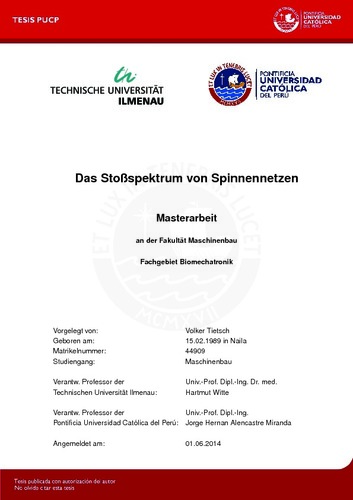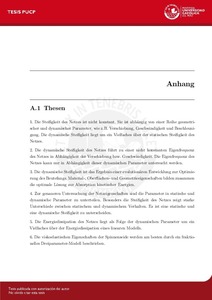| dc.contributor.advisor | Alencastre Miranda, Jorge Hernán | |
| dc.contributor.author | Tietsch, Volker | es_ES |
| dc.date.accessioned | 2015-08-19T16:28:34Z | es_ES |
| dc.date.available | 2015-08-19T16:28:34Z | es_ES |
| dc.date.created | 2014 | es_ES |
| dc.date.issued | 2015-08-19 | es_ES |
| dc.identifier.uri | http://hdl.handle.net/20.500.12404/6234 | |
| dc.description.abstract | Die vorliegende Arbeit präsentiert Grundlagen, Versuchstechniken und neue Erkenntnisse des Systems Spinnennetz. Die bereits vorhandenen Kenntnisse über dieses Vorbild aus der Natur werden erweitert und bemerkenswerte Eigenschaften identifiziert.
Spinnenseide ist ein herausragendes Biopolymer, dass herkömmliche synthetische Fasern in einer Reihe von Eigenschaften übertrifft. Der Bionik und Materialforschung ist es ein Anliegen diese Fähigkeiten zu nutzen. Besonders die Fähigkeiten der Seide zur Absorption kinetischer Energien stechen hervor. Neuste Fortschritte in der rekombinaten Herstellung versprechen, diesen Werkstoff in naher Zukunft in großen Mengen synthetisch herstellen zu können.
Zu Beginn wird ein Überblick über die besonderen Eigenschaften von Spinnenseide und -netz, sowie den bisherigen Forschungsstand gegeben. Außerdem werden die notwendigen mathematischen Grundlagen zur Analyse von Schwingungen erarbeitet. Dabei wird außerdem das Shock Response Spectrum (SRS) und dessen Berechnungsmethoden erläutert. Anhand verschiedener Quellen wird
ein standardisiertes SRS entworfen und in Form eines Matlab-Skriptes implementiert.
Für die Versuche werden Netze der Spinnenart Argiope Argentata verwendet. Zur Vermessung wird ein Versuchsaufbau entworfen und aufgebaut, um die Netze mit Projektilen in Schwingung zu versetzen. Die resultierenden Schwingungen werden mit Interferometern aufgezeichnet.
Mit einer Reihe von Auswertungsskripten werden die Messungen detailliert analysiert, um Eigenschaften zu identifizieren und zu quantifizieren. Außerdem wird das SRS des Netzes berechnet.
Dabei zeigt sich, dass das Netz ein dynamisches System ist, dessen Eigenschaften nur beschränkt durch bisherige, lineare Modelle beschrieben werden können. Insbesondere die Steifigkeit kann als dynamischer Parameter ausgemacht werden. Eine Reihe weiterer Parameter, wie z.B. die Energiedissipation werden quantifiziert.
Im Anschluss wird ein erweitertes Modell entwickelt, dass die dynamischen Parameter berücksichtigt.
Ein Vergleich mit den Messergebnissen zeigt die sehr gute Übereinstimmung des erweiterten, dynamischen Modells. Um weitere Details der Eigenschaften zu untersuchen, werden außerdem die viskoelastischen Materialeigenschaften in ein dynamisches Materialmodell aufgenommen.
Ergebnis der Arbeit sind neue Kenntnisse über das System Spinnennetz, die die Erwartungen übertreffen. Zum Abschluss wird ein detaillierter Ausblick gegeben, um das Forschungsthema im breitem Umfang fortzusetzen. Die Arbeit präsentiert dazu mehrere Ansätze. | es_ES |
| dc.description.abstract | The work in hand presents basics, experimental techniques and new insights on the system spider web. The knowledge about this natural paragon is enhanced and remarkable properties are identified.
Spider silk is an outstanding bio polymer that shows promising properties and exceeds conventional synthetic silks in many properties by far. It is a long desire of bionic and material science to use these abilities. Especially the capability of the silk to absorb relatively high kinetic energies is outstanding. New progress in the recombinant production is promising to produce it in the near future in great quantities.
First an overview of the special properties of spider silks and the web is given. After that the necessary mathematical basis for the analysis of vibrations is worked out. Under this point the Shock Response Spectrum (SRS) and his calculation methods are explained. Based on different sources a standardized SRS is developed and implemented in a Matlab-script.
In the experiments webs of the spider specie Argiope Argentata are used. For the measurements an experimental setup is developed and put in place to use projectiles to stimulate vibrations of the webs. The resulting vibrations are measured with laser interferometers.
Using developed evaluation scripts the measurements are analysed in detail to identify and quantify properties. In addition the SRS is calculated. It is shown that the web is a dynamic system and the properties can only narrowly be described using previous linear models. Especially the stiffness is determined as a dynamic parameter, that depends on displacement and velocity. A series of additional parameters as for example the energy dissipation are quantified.
Following an extended model is developed, which considers the dynamic parameters. A comparison with the measurements shows the excellent accordance of the extended dynamic model. To investigate other details of the properties the viscoelastic material properties are added to a dynamic material model.
The result of the work is enhanced knowledge about the system spider web, which extends previous expectations.
At the end a detailed outlook is given to continue the research topic in a broad scope. For this several approaches are presented. | es_ES |
| dc.description.uri | Tesis | es_ES |
| dc.language.iso | deu | es_ES |
| dc.publisher | Pontificia Universidad Católica del Perú | es_ES |
| dc.rights | info:eu-repo/semantics/openAccess | es_ES |
| dc.rights.uri | http://creativecommons.org/licenses/by-nc-nd/2.5/pe/ | * |
| dc.subject | Fibras compuestas | es_ES |
| dc.subject | Seda de araña | es_ES |
| dc.title | Das Stoßspektrum von Spinnennetzen | es_ES |
| dc.type | info:eu-repo/semantics/masterThesis | es_ES |
| thesis.degree.name | Maestro en Ingeniería Mecánica | es_ES |
| thesis.degree.level | Maestría | es_ES |
| thesis.degree.grantor | Pontificia Universidad Católica del Perú. Escuela de Posgrado | es_ES |
| thesis.degree.discipline | Ingeniería Mecánica | es_ES |
| renati.advisor.dni | 10588073 | |
| renati.advisor.orcid | https://orcid.org/0000-0001-8442-8255 | es_ES |
| renati.discipline | 713347 | es_ES |
| renati.level | https://purl.org/pe-repo/renati/level#maestro | es_ES |
| renati.type | http://purl.org/pe-repo/renati/type#tesis | es_ES |
| dc.publisher.country | PE | es_ES |
| dc.subject.ocde | https://purl.org/pe-repo/ocde/ford#2.03.01 | es_ES |







